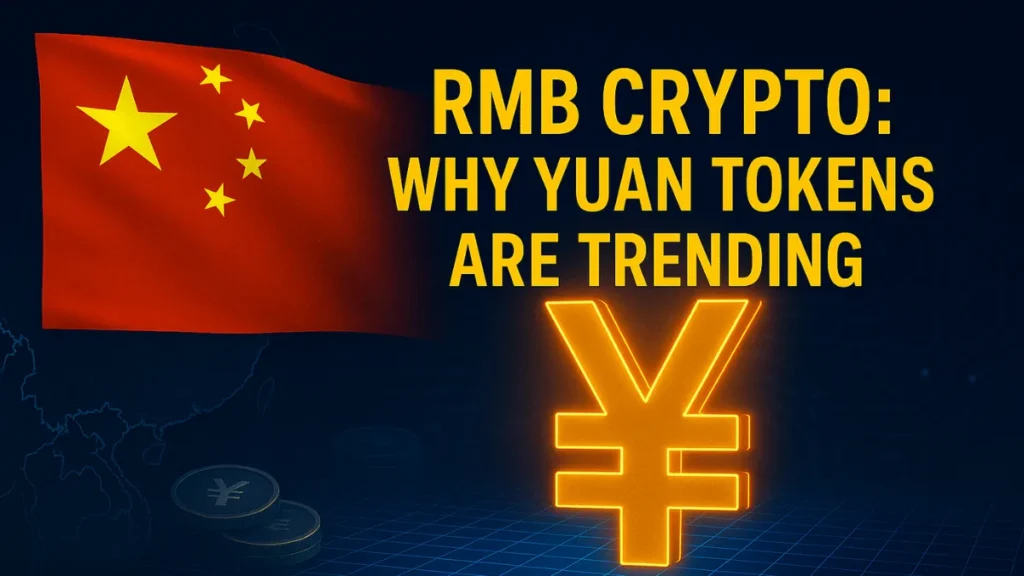The global spotlight is now shining on Chinese yuan-backed digital currencies, particularly the Digital Renminbi (e-CNY) and offshore yuan-pegged stablecoins. These developments are not just reshaping China’s domestic economy but are also triggering geopolitical ripples that may redefine the future of global finance.

What Is RMB Crypto?
At its core, RMB crypto refers to digital versions of the Chinese yuan, especially:
- e-CNY (Digital Yuan): A central bank digital currency (CBDC) issued by the People’s Bank of China (PBOC), aimed at digitizing the Chinese economy.
- Yuan-Backed Stablecoins: These are digital tokens pegged to the Chinese yuan, often issued outside mainland China, used in offshore markets for cross-border trade.
Unlike Bitcoin or Ethereum, these currencies are centrally issued and regulated, with varying degrees of state involvement.
China Strategic Digital Leap: e-CNY Explained
The Digital Currency Electronic Payment (DCEP) initiative began in 2014 and has grown into one of the world’s most advanced CBDC projects. The e-CNY is legal tender and functions both online and offline—users can pay via mobile apps or SIM card-based wallets without internet connectivity.
Key Features:
- Programmable money with smart-contract capabilities.
- Offline payments using NFC-enabled wallets.
- Controlled anonymity, giving the state visibility over transactions while attempting to preserve user privacy.
As of 2023, over 261 million users have participated in e-CNY pilot programs, with trials covering major cities like Shenzhen, Suzhou, and Beijing. In 2024, it was even used in crude oil transactions by PetroChina, signaling its move toward global commodity settlements.
Why Chinese Yuan Tokens Are Trending
China’s RMB crypto surge is widely viewed as a geopolitical counterweight to U.S. dollar dominance. By offering a state-backed alternative, China aims to:
- Reduce exposure to SWIFT-based sanctions.
- Enable cross-border trade outside the traditional USD system.
- Support its Belt and Road Initiative with digital infrastructure.
Offshore yuan-backed stablecoins, especially in Hong Kong, are gaining traction as tools for cross-border e-commerce and remittances.
Currency Devaluation & Capital Flight
With the yuan facing devaluation pressure in recent years, Chinese investors and global partners are increasingly turning to crypto solutions to hedge against economic uncertainty. Yuan-tied digital assets are seen as less volatile than speculative cryptocurrencies and offer government-backed stability.
Innovation Meets Surveillance
RMB crypto also provides unprecedented control and data collection. Every transaction through e-CNY is trackable, enabling:
- Crackdown on corruption and financial fraud.
- Instant freezing of illicit funds.
- Targeted economic stimulus using programmable money.
While hailed for its efficiency, this also raises significant privacy concerns, especially among international observers and human rights organizations.
The Role of Big Tech and FinTech
Tech giants like Alibaba, Tencent, and Huawei are actively involved in developing wallets and integration points for the e-CNY. Despite their past regulatory clashes with Beijing, their cooperation highlights the strategic priority of digital yuan rollout.
Moreover, with 90% of China’s population using WeChat Pay or Alipay, the government is gradually positioning e-CNY as a complement or even replacement of these platforms in certain areas—especially public services and infrastructure payments.
Global Financial Implications
The digital RMB is a game-changer in international finance:
- It’s part of the mBridge project in collaboration with the Bank for International Settlements (BIS), exploring multi-CBDC interoperability for cross-border payments.
- Emerging economies in Africa, Asia, and the Middle East are testing or considering using e-CNY for loans, trade, and aid from China.
- The U.S. and EU are closely monitoring the rollout, with the digital euro still in exploratory phases and the U.S. only in early research on a digital dollar.
Challenges Ahead
Despite its momentum, RMB crypto faces several hurdles:
- Capital controls restrict international investors from freely accessing RMB assets.
- Skepticism abroad about China’s surveillance practices and monetary policy transparency.
- The dominance of the U.S. dollar, which still makes up over 60% of global reserves, compared to the yuan’s mere 2%.
Experts like Eswar Prasad and Victor Shih argue that while e-CNY can accelerate renminbi internationalization, it alone won’t dethrone the dollar without broader reforms.
Final Thoughts
The rise of Chinese yuan tokens—from centralized e-CNY to offshore stablecoins—reflects China’s strategic use of technology to redefine financial sovereignty, challenge dollar dominance, and assert geopolitical influence.
While global adoption is far from guaranteed, the trend is unmistakable: RMB crypto is more than a technical innovation—it’s a geopolitical maneuver with far-reaching implications.

